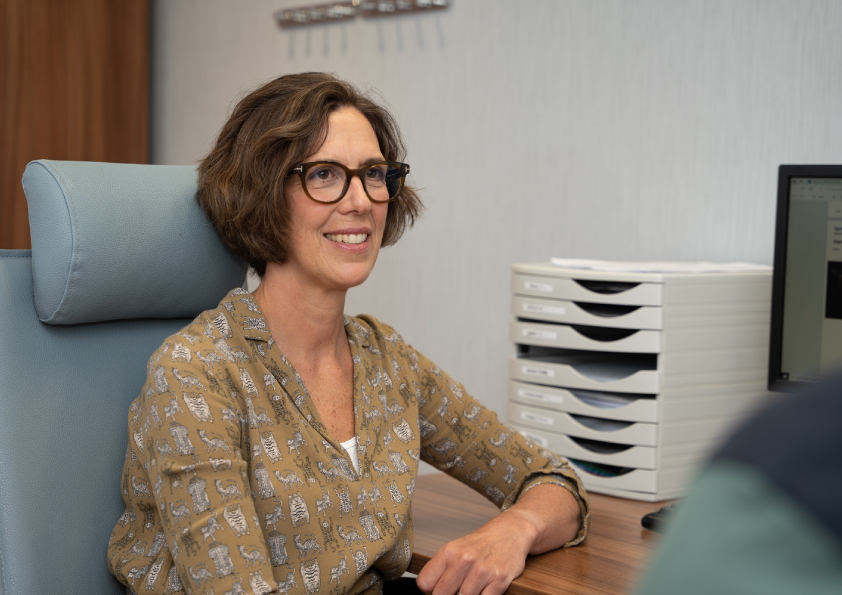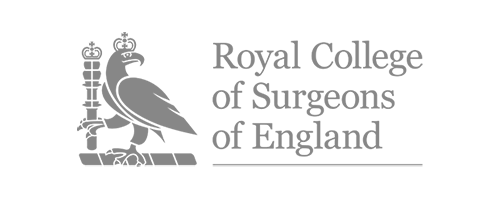COMMON COLORECTAL TREATMENTS
Ms Burt works with a multi-disciplinary team including radiologists, oncologists and specialist nurses to provide the best possible clinical outcomes. See has expertise in treating patients using the most advanced techniques in bowel surgery including laparoscopic (keyhole) surgery. She also specialises in the treatment of the more common conditions such as haemorrhoids with modern techniques .
An overview of the most common treatments are detailed below. For information about any additional bowel treatments not featured within the site, please contact us for more information.
A colonoscopy procedure is an examination of the lining of the colon (large bowel) using a thin flexible, tube-like telescope called a colonoscope. This is carefully passed through the back passage and into the colon.
A colonoscopy is useful for finding out what is causing symptoms, or as a check-up for certain bowel conditions. During the colonoscopy procedure, Ms Burt may take one or more biopsies (samples of the lining of the colon) for examination in a laboratory. It’s also possible to remove polyps (small lumps of tissue that may be found on the colon lining).
Colonoscopy is routinely done as an out-patient or day-case procedure, with no overnight stay. It’s usually performed under sedation to help ensure that you are relaxed and comfortable during the procedure. After sedation, most people have very little memory of the test.
Ms Burt will explain the benefits and risks of having a colonoscopy, and will also discuss the alternatives to the procedure. Depending on your symptoms, alternatives may include sigmoidoscopy, virtual colonoscopy and CT colonography.
What happens during a colonoscopy procedure?
For Ms Burt to see the lining of your colon clearly, it needs to be completely empty. To achieve this, you will need to follow a special diet for a few days before the procedure and you will be asked not to eat any solids on the day before your examination. You will also be given a laxative, which will come with detailed instructions on how and when to take it.
If you are having sedation, this may be given through a small plastic tube (cannula) placed in a vein in the back of your hand. You may need oxygen through a mask during the procedure and for a short time afterwards.
With you resting on your side, Ms Burt will examine your back passage with a finger before carefully inserting the colonoscope. Lubricating jelly will be used to make this as easy as possible.
Air will be passed through the tube and into the colon to make the lining easier to see. When this happens, you may briefly feel pains similar to trapped wind. You may also feel that you want to go to the toilet, but as the colon is empty, this will not be possible. You may pass wind, but try not to feel embarrassed, as the staff expect this to happen.
At the end of the colonoscope, a tiny light and lens allow Ms Burt to see the lining of the colon. The lining is examined by looking directly through the colonoscope, or at pictures it sends to a video screen.
During the procedure, you may be asked to change your position – for example turning from your side onto your back. This helps Ms Burt to examine different areas of the colon with the colonoscope more easily. If necessary, a small biopsy will be taken for analysis. Any polyps that are found can also be removed. This is done using special instruments passed inside the colonoscope, and is quick and painless.
Afterwards, the colonoscope is removed quickly and easily. The procedure takes about 20 to 30 minutes to perform and may be a bit uncomfortable.
After the examination, you may feel bloated and have wind pains, but these usually clear up quite quickly. The sedative may make you feel sleepy. If a biopsy has been taken or a polyp has been removed, you may experience a small amount of bleeding from your back passage after the procedure.
What are the risks of a colonoscopy?
Colonoscopy is a commonly performed and generally safe procedure. For most people, the benefits of having a clear diagnosis are much greater than any disadvantages. However, like all medical procedures, there are some risks.
Ms Burt is extremely experienced at performing colonoscopies but even so, occasionally a colonoscopy is not completed successfully and may need to be repeated.
Other complications are uncommon. It’s possible for the colon to be damaged or, in very rare cases, perforated during the procedure. This can lead to bleeding and infection, which may require treatment with medicines or surgery.
The chance of complications depends on the exact type of procedure you are having and other factors such as your general health. Ask Ms Burt to explain how any risks apply to you.
A flexible sigmoidoscopy is a test that allows Ms Burt to look inside the rectum and lower part of your bowel using a narrow, flexible, tube-like telescope called a sigmoidoscope. This is carefully inserted into your back passage.
The test can help find out what is causing symptoms such as changes in bowel habit or rectal pain. It is also used to check for inflammation, early signs of cancer and polyps. During the procedure, Ms Burt may take one or more biopsies (samples of tissue) for examination in a laboratory.
If necessary, it’s possible to remove polyps and treat haemorrhoids during the procedure. Flexible sigmoidoscopy is routinely done as an out-patient procedure. Ms Burt will explain the benefits and risks of having a sigmoidoscopy, and will discuss alternatives to the procedure. Depending on your symptoms, alternatives may include:
colonoscopy
virtual colonoscopy
barium enema
About the procedure
For Ms Burt to see clearly, the bowel needs to be completely empty. To help clear it out you will be asked to:
• eat a light meal the day before and drink plenty of clear fluids
• take a strong laxative or an enema that is designed to empty your bowel – you will be given instructions on how and when to take this
The procedure usually takes 10 to 15 minutes. It will feel uncomfortable, but shouldn’t be painful. Whilst you are resting on your side, Ms Burt will gently examine your back passage with a gloved finger before carefully inserting the sigmoidoscope. Lubricating jelly will be used to make this as easy as possible.
Air is then usually pumped through the tube into the lower bowel to make it expand and the bowel wall easier to see. This may cause stomach cramps and you may get an urge to go to the toilet or pass wind.
A camera lens at the end of the sigmoidoscope sends pictures from the inside of your bowel to a TV screen. Ms Burt will look at these images. During the procedure, you may be asked to change your position, for example, turning from your side onto your back. This helps him to examine different areas of the bowel more easily.
If necessary, Ms Burt will take a biopsy and/or remove polyps. This is done using special instruments passed inside the sigmoidoscope.
Afterwards, you may feel bloated and have stomach cramps, but these usually clear up quickly. You may also have a little blood in your faeces.
Flexible sigmoidoscopy is a commonly performed and generally safe procedure. For most people, the benefits in terms of having a clear diagnosis are much greater than any disadvantages. However, all medical procedures carry an element of risk.
Specific complications to sigmoidoscopy are uncommon, but it’s possible to damage or, in very rare cases, perforate the lower bowel or rectum during the procedure. This can lead to bleeding and infection, which may require further surgery or treatment with medicines.
Ms Burt is extremely experienced at performing the procedure, but even so, occasionally a sigmoidoscopy is not successfully completed and may need to be repeated.
You should ask Ms Burt to explain how any risks apply to you. The exact risks will differ for every person which is one of the reasons why we have not included any statistics here.
Haemorrhoid removal treatment or haemorrhoidectomy is an operation to remove haemorrhoids (piles) from the anus. Haemorrhoidectomy is usually carried out as a day-case procedure, with no overnight stay in hospital.
The operation is usually performed under general anaesthesia. This means you will be asleep throughout the procedure. Some people choose epidural anaesthesia instead. This numbs your body from the waist down, but you will still be awake.
Ms Burt will explain the benefits and risks of having your haemorrhoids removed, and will discuss the alternatives to the procedure.
About the operation
There are a number of techniques for removing haemorrhoids. The most common technique involves placing a tight stitch (ligature) around the base of the haemorrhoid to control any bleeding during the operation. Then, Ms Burt will make a cut on the outer part of the haemorrhoid and remove any excess tissue. The wound may be closed with dissolvable stitches. Most of the stitches will be inside the anal canal. These stitches will dissolve over about two to four weeks.
Ms Burt may place an absorbent pack into your rectum to help stem any further bleeding. This usually stays in place until your first bowel movement. The operation usually takes 30 to 60 minutes.
Another technique is called circular stapled haemorrhoidectomy. A circular stapler is placed inside the rectum. It removes a ring of the rectal tissue above the haemorrhoids. This blocks the blood supply to the haemorrhoids so that they shrink.
After a haemorrhoidectomy, you will have some pain at the site of the operation for a few days and there may be a small amount of bleeding or discharge from the anus.
Haemorrhoidectomy is a commonly performed and generally safe surgical procedure. For most people, the benefits are greater than any disadvantages. However, all surgery carries an element of risk.
Specific complications of a haemorrhoidectomy are unusual but can include:
• constipation for a few days after the operation
• an infection of the operation site or the urinary tract
• the stitches coming apart, leaving an open wound – this usually heals quickly
• scar tissue causing the anus to become tighter (stenosis), which can make it difficult to pass stools – you may need treatment called anal dilation
• bleeding that starts a week or more after the operation, which may require further surgery
The chance of complications depends on the exact type of operation you are having and other factors such as your general health. Ask Ms Burt to explain in more detail how any risks apply to you.
A hernia operation is intended to repair and strengthen the abdominal wall. The intestine is pushed back into its correct place, and a synthetic mesh is often used to strengthen the weak spot.
What does a hernia operation involve?
Open hernia repairs can be undertaken under local or general anaesthetic. Laparoscopic hernia repair is usually undertaken under general anaesthetic. The procedure normally takes around 45 minutes and you may be also able to go home the same day.
There are four common types of hernia and two main types of treatment:
Inguinal hernia – groin
When a hernia occurs in the lower abdomen area it is known as an inguinal hernia. As the most common type of hernia, it accounts for over three out of every four cases.
There are two ways this type of hernia can be repaired:
• Laparoscopic (keyhole) inguinal hernia repair
Ms Burt would refer you to a gastroenterologist at the Spire for this procedure. They would make two or three small cuts to your abdomen, through which a tube-like camera will be passed to enable your surgeon to view the hernia. Special surgical instruments are then used to repair the hernia and a synthetic mesh may be used to strengthen the abdominal wall.
• Open inguinal hernia repair
A single incision of around 5-10cm is made in the groin and the bulge is pushed back into place. A mesh may be used to support the area. The skin is then closed using dissolvable stitches.
Femoral hernia – lower groin
A femoral hernia also occurs in the groin area; however this type is positioned a little lower down than an inguinal hernia and is more common in women. There is a high risk of serious problems if femoral hernias are left untreated.
Femoral hernias can be repaired through the same methods as an inguinal hernia, through laparoscopic and open surgery.
Incisional hernia – resulting from a previous incision
Incisional hernias result from a weakness in the abdominal wall caused by a previous scar or surgical wound that has not healed well. They usually occur within two years of the surgery.
Incisional hernias vary in size and the treatment prescribed may also vary. Usually open surgery will be carried out, with a mesh being stitched over the weak spot for larger hernias. The incision will then be closed with stitches.
Umbilical hernias – navel
Umbilical hernias appear around the navel (belly button) and can be present from birth. As such, they are most common in children and usually heal without surgical treatment.
A hernia operation will be needed if the umbilical hernia does not go away on its own. Adults who develop this type of hernia will need treatment as it will not get better on its own.
Laparoscopic bowel surgery is a specialized ‘minimally invasive’ technique for performing major bowel surgery. The surgeon uses several 0.5-1 cm stab incisions (key-holes), a specialized camera and special keyhole instruments to perform the operation rather than the traditional ‘open’ technique which uses a single long up-down incision in the center of the abdomen (tummy). The camera transmits images to a high definition video monitor allowing surgeons to perform the operation through the key-holes.
Laparoscopic bowel surgery has been shown to result in less post-operative pain, quicker recovery and reduced complications ((i.e. safer that traditional open surgery). Patients are often able to go home within 3-5 days of major bowel surgery. It also results in lesser scarring.
Ms Burt is an expert laparoscopic surgeon who undertakes laparoscopic surgery for bowel cancer and a variety of other bowel conditions routinely. Up to 80% of patients who need bowel surgery are suitable for laparoscopic surgery. The surgery is performed using the latest equipment.
It is an examination of your oesophagus (gullet), stomach and duodenum (the first part of the small intestine). This is done using a thin, flexible, tube-like telescope called an endoscope. The endoscope is passed through the mouth and into the gullet. The test may also be simply referred to as an endoscopy, or OGD (oesophagogastro-duodenoscopy).
A gastroscopy is useful for finding out what is causing symptoms, or as a check-up for certain gastrointestinal conditions. During the procedure, the surgeon may take a biopsy – a sample of the lining of the oesophagus, stomach or duodenum – for laboratory analysis. Gastroscopy is routinely done as an out-patient or day-case procedure, with no overnight stay. You may be given a sedative to help ensure that you are relaxed and comfortable during the procedure. After sedation, most people have very little memory of the test.
Ms Burt will explain the benefits and risks of having a gastroscopy, and will also discuss the alternatives to the procedure.
COMMON COLORECTAL INVESTIGATIONS
A computerised tomography (CT) scan, also known as a CAT scan, uses x-rays and a computer to create detailed images of the inside of your body.
Abdominal and pelvic CT scans allow the radiologist to visualise the different organs/ viscera within the abdomen and pelvis and inspect them for signs of disease.
The scan is usually performed with the patient lying on their back and involves only a part of the body entering a short tunnel. CT scans are painless and normally take about 15-20mins. They might sometimes involve an intravenous injection of a contrast (special dye) to help identify different structures within the body better.
A CT colonography/ CT enema/ virtual colonoscopy uses the CT scanner and special computer graphics to digitally reconstruct images of the large bowel akin to what is seen during a colonoscopy. The test involves full bowel preparation using strong laxatives (at home the day before) and an insertion of a soft tube into the back passage and insufflation of air into the bowel. The examination takes about 45 minutes.
An endoscopy is a procedure where the gut (or other tube-organ) is examined internally using an endoscope. An endoscope is a thin, long, flexible tube that has a light source and a video camera at one end. Images of the internal aspect of the gut are relayed and projected on an external television screen.
A gastroscopy is a camera examination of the stomach and first part of the small bowel. The endoscope is passed through the mouth into the gullet. The test is performed either with throat spray (a local anaesthetic spray that numbs your throat) or light sedation and normally takes about 5 minutes.
A colonoscopy is a camera examination of the large bowel. The colonoscope is passed through the back passage and around the large bowel which is roughly a meter in length. The test required cleansing of the bowel prior to the examination by the use of strong laxatives called bowel prep (Moviprep) at home the day before. Colonoscopy is usually performed under light sedation but can also be performed un-sedated. The examination usually takes between 15 to 30 minutes.
A flexible sigmoidoscopy is similar to a colonoscopy but only the left part of the large bowel is inspected. The test can be done after administering an enema without bowel prep. It is usually performed without sedation, but some patients may choose to have sedation. The procedure takes about 5-10 minutes.
Magnetic resonance imaging (MRI) scanners use strong magnetic fields and radio waves to produce detailed images of the inside of the body. An MRI scanner is a large tube/ tunnel that contain a series of powerful magnets. The patient has to lie inside the tube during the scan. It is a painless and harmless procedure but some patients may find it claustrophobic. The examination takes about 15 to 90 minutes.
Discussion with Ms Burt is important to answer any questions that you may have. For information about any additional treatments that are not featured within the site, please contact us for more information.








